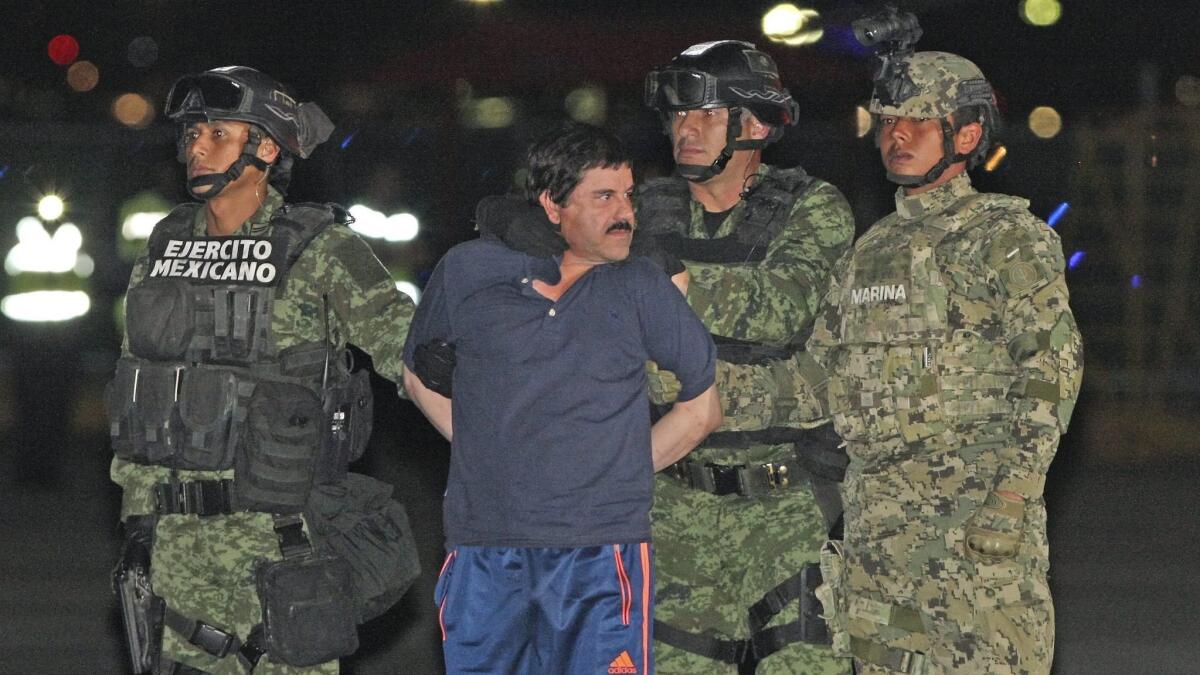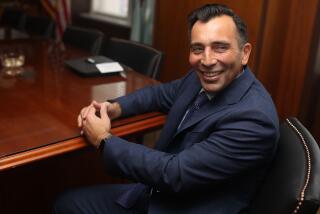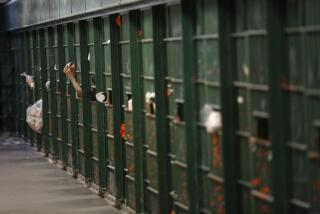$100 million is ordinary money in the world of ‘El Chapo’

In any other context, the nine-figure bribe former Sinaloa cartel secretary Alex Cifuentes told New York jurors he arranged for a Mexican president-elect would defy belief.
But for the mega-rich narcoratti who have lined up to testify in the ongoing trial of Mexican drug kingpin Joaquin “El Chapo” Guzman, $100 million is just the price of doing business.
“We need to think about these organizations as multibillion-dollar corporations,” said David Shirk, a professor of international relations at the University of San Diego and a drug trade expert. “When you think of these guys not as colorful thugs but as captains of industry, it’s really easy to understand why there’s so much money involved.”
Still, the dollar amounts tossed around in testimony have been eye-opening for many experts, who estimate that the U.S. narcotics trade is worth as much as $40 billion a year, on par with worldwide revenue at Coca-Cola Co. But they rarely get to hear directly from the illegal drug industry’s senior executives.
Eleven former cartel officials have testified for the prosecution since the trial started in early November, with many more expected to take the stand before it’s over.
Most are in federal prison waiting to be sentenced for drug trafficking, murder and other crimes and hope their testimony will be rewarded with shorter sentences and special visas for their families. The few who are free are in witness protection.
Guzman, who has already been convicted of drug trafficking in Mexico, is being tried in federal court on charges of trafficking, conspiracy to commit murder and weapons violations. Most of the witnesses worked closely with him.
They are the cornerstone of the prosecution’s case — and its biggest liability. Guzman’s lawyers have seized on the details of their lives to portray them as deceitful, unreliable and out for themselves.
The saga of ‘El Chapo,’ one of the world’s biggest drug kingpins »
Cross-examination has produced tales of wealth that often sound less like legal testimony than a spec script for “Lifestyles of the Rich and Infamous.”
Tirso Martinez, a self-taught systems engineer who built train lines for the cartel and managed its smuggling routes, spent lavishly on sports teams, racehorses and restaurants, losing close to $2 million on cockfights alone before his arrest in Mexico in 2014.
Before he landed in Mexican prison in 1998, Guzman’s longtime lieutenant Miguel Angel “El Gordo” Martinez eroded his septum blowing through 4 grams of cocaine a day, and frequently interrupted meetings to insufflate the drug from a gold vial inlaid with diamonds.
Alex Cifuentes’ brother, the Colombian narco Jorge Cifuentes, said he funneled his ill-gotten gains into a dozen different legitimate businesses, hemorrhaging cash until his arrest in 2012.
And Chicago drug boss Pedro Flores, who has been in federal custody since 2008 and is expected to join his family soon in witness protection, still owns several properties in Mexico, though he told jurors he would be indicted for money laundering if he ever tried to sell them.
Vanda Felbab-Brown, a senior fellow at the Brookings Institution and an expert on the international drug trade, said she was paying close attention to the Guzman trial.
“Estimating the size of illicit economies is magic rather than science,” she said. “Estimating the size of individual profits is even more difficult.”
One number in particular stood out to her: $1.3 billion.
That’s how much — in cash, real estate and other assets — Vicente Zambada, the son of Guzman’s partner and purported successor Ismael “El Mayo” Zambada, told the court he agreed to forfeit to the U.S. government when he pleaded guilty to drug trafficking in 2013. It was unclear how much of that the government has actually seized.
“I was really shocked by that number and found it hard to believe,” Felbab-Brown said.
But other experts said it made sense.
“It’s reasonable to say that at a minimum, these guys were running a $6-billion industry, and the number of firms competing in that industry was very small,” Shirk said. “For an individual like Guzman, we’re surely in the hundreds of millions annually, and a billion is not impossible and is in fact quite probable in terms of net worth.”
The fearsome head of Colombia’s North Valley cartel, Juan Carlos “Chupeta” Ramirez Abadia, told jurors that he too forfeited a billion in assets. A video clip taken just after his arrest in 2007 and played for jurors showed mansions and yachts brimming with scores of designer watches and other luxury goods.
“I was super rich,” he told the court.
His operational costs were also immense. He kept meticulous ledgers, which tracked millions of dollars in drug shipments, as well as business expenses, including pricey hit jobs and tons of ice and fresh fish to back his drug boats’ cover.
“How come so much money for this person?” defense attorney William Purpura inquired about a $333,000 assassination listed on an Excel spreadsheet.
“It was a big group of hit men who took part in that killing,” Ramirez Abadia said.
He later told the court he paid for nearly 40 other killings tied to just that one feud.
Therein lies the rub, Felbab-Brown explained.
The drug industry is dominated by a handful of major players, but those men rely on networks of thousands for day-to-day operations, from drivers and engineers to bodyguards and hit men, all of whom must be paid in cash.
“No sicario with any kind of brain will agree to be paid in bitcoin,” she said. “You need liquidity, because you need to be able to grab the money and run.”
Still more cash is required to buy off law enforcement and politicians, whose precise role in the narcotics business has been deliberately veiled at several key points in the trial.
Guzman’s attorneys have at times been strictly limited in what they can ask about bribes.
“Individuals and entities who are not party to this case would face embarrassment and harassment if this information were made public,” Judge Brian Cogan told the court in November, after an extended back-and-forth over what precisely Sinaloa cartel deputy Jesus “El Rey” Zambada Garcia would be permitted to say about a series of political payoffs.
But damning allegations have nevertheless emerged — most recently the testimony last week from Cifuentes, who claimed he was carrying out orders from Guzman when he arranged the $100-million payment to Enrique Peña Nieto in October 2012, two months before he was inaugurated president.
Back in November, Zambada testified that he personally passed millions in cash to two high-ranking Mexico City officials, including one with close ties to current Mexican President Andres Manuel Lopez Obrador, while Colombian public defender turned narco-fixer German Rosero told the court in December that he had convinced rival cartels to rally each of their corrupt politicians for a crucial vote.
Both Lopez Obrador and Peña Nieto have vigorously denied the corruption claims.
Human resources are far from the drug traffickers’ only expense. Even before the trial, the Sinaloa cartel was famed for its use of exotic vehicles — including planes, trains and submarines — to move hundreds of tons of drugs.
Shipments were frequently disguised with real goods, including fresh produce and even livestock. Flores described a load of drugs arriving at one of his warehouses in a truck full of bleating sheep, though he was prevented from telling jurors what happened to the animals.
Still more money was required to house the drugs. Witnesses have testified that the cartel controlled a thick real estate portfolio of warehouses across Mexico and stash houses dotting the United States.
Unlike street dealers, who often keep small caches of drugs in their own apartments, Flores told the court that he ordered workers to find “beautiful” properties in “upscale” neighborhoods in which police were less vigilant and neighbors kept their business to themselves.
One particularly tony stash house “had a beautiful view of the Brooklyn Bridge,” he recalled.
But by far the most costly of any cartel’s operations are its wars, which experts say have escalated across Mexico in the aftermath of Guzman’s arrest. Whenever one narco-oligarch falls, others rise to try to take his place, spurring terrible bloodshed and ruinous expense.
Shirk said that for drug traffickers, violence is simply a business strategy.
“If they could take someone to court for failing to provide a shipment, they wouldn’t need to kill them,” he said.
More to Read
Start your day right
Sign up for Essential California for news, features and recommendations from the L.A. Times and beyond in your inbox six days a week.
You may occasionally receive promotional content from the Los Angeles Times.







